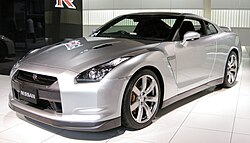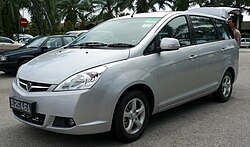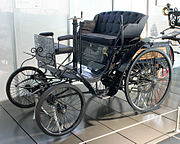 | |
| Manufacturer | Nissan Motors |
|---|---|
| Also called | Fairlady Z (Japan) |
| Production | 2009- |
| Assembly | Tochigi, Tochigi Japan |
| Predecessor | Nissan 350Z |
| Class | sports car |
| Body style(s) | 2-door coupé 2-door roadster |
| Layout | FMR layout |
| Platform | Nissan FM platform |
| Related | Infiniti G Nissan Skyline |
Design
The Nissan 370Z is a front-mid engine rear-wheel-drive two door sports coupe. The vehicle features the long-hood short-deck design common to the Z-Car family continuing the tradition of exchanging trunk room for increased performance. External design highlights include a sloping fastback style roof line, high waistline, angular headlights/taillights and bulging fenders that are pushed out to the corners of the vehicle.
Interior cabin design is designed to be driver focused. As with the 350z and G35, the driver's gauges (speedometer, tachometer, fuel, heat) is mounted directly to the steering column allowing their movement to coincide with steering wheel adjustments. Additional gauges are mounted in a center triple gauge cluster. The gauge display for the gas and engine temperature are replaced by a LED meter, and the steering wheel and climate controls are similar to the Nissan Maxima. A navigation system with iPod integration replaces a storage bin on the center console with a controller and monitor that is used with the current Nissan Maxima, Nissan Murano, and several Infiniti models.
Changes from the 350Z include a straighter and sharper A-pillar (similar to the GT-R), new aggressive-inspired headlights, intelligent key system, more pronounced fender arches, new rocker panels and a new liftgate.[5] Additionally, the 370Z does make use of a conventional glove box. Other changes include new updated interior materials and patterns, with more focus on quality [caranddriver.com], lighter overall curb weight, a new synchro rev match throttle blipping program, updated gauges and stereo, optional sport package, and an updated optional touch screeen navigation system [Nissanusa.com]
During the 370Z's development, Nissan claims that the Porsche Cayman was the performance target goal, yet the end result is a car that is similar in weight, with more power, and at a lower price. The newly designed Cayman produces 265 hp (198 kW) in its basic configuration, with the 320 hp (239 kW) Cayman S worth almost $10,000 more.
The 370Z is currently offered in two main trims, the Base model and the Touring model. Both trims can be equipped with the Sport Package which delivers 19" lightweight forged wheels with Bridgestone Potenza tires, a rear viscous limited slip differential, the Aerodynamics package (which has a front chin spoiler and a rear lip spoiler), SynchroRev Match (for manual transmission), and finally, an improved brake system with four piston Nissan Motorsports brakes in the front and two piston brakes in the rear.
Engineering
Almost every piece and component of the 370Z has been redesigned. It is powered by the VQ37VHR 3.7 L (230 cu in) DOHC V6 with Variable Valve Event and Lift Control and produces 332 bhp (248 kW; 337 PS). Power delivery to the rear wheels comes through a new 7-speed automatic transmission with paddle shifters or 6-speed manual transmission which features the world's first synchronized downshift rev-matching system or SynchroRev Match. The differential offered with the Sport Package is indicated to be a viscous limited slip differential manufactured by Torsen.
Compared to the 350Z, the 370Z has a wheelbase 4 in (100 mm) shorter at 100.4 in (2,550 mm) and an overall length 2.7 in (69 mm) shorter at 167.1 in (4,240 mm). The overall width has been increased by 1.3 in (33 mm), the rear track by 2.2 in (56 mm), and overall height reduced by 0.3 in (7.6 mm). The smaller exterior dimensions and use of more lightweight materials help reduce weight. (Although it should be noted that a 2003-2005 base model 350Z is actually lighter in weight than the 370Z). The 370Z features a front aluminum subframe, aluminum-alloy engine cradle, aluminum door panels, an all-aluminum hood, and an aluminum hatch.
Front body torsion rigidity is improved by 30 percent with an extensively revised body structure which includes a new front suspension cradle to reduce front body lateral bending, new rear structural reinforcements, and an underbody "V-bar" to help reduce rear lateral bending. Additional enhancements include the use of a carbon fiber composite radiator housing and strengthening of the rear fender and hatch areas. Rear body torsion rigidity is improved by up to 22 percent and rear body vertical bending rigidity is improved by up to 30 percent. The new structure weighs slightly less than the 350Z's.
The coefficient of drag is 0.30 and 0.29 with the Sport Package, figures identical to the 350Z.
NISMO 370Z (2009-)
The Nismo version was introduced for the 2009 year model. The engine produces 350 bhp (261 kW) at 7,400 RPM and 276 lb·ft (374 N·m) at 5,200 RPM with revised ECU settings and exhaust setup. Transmission choice is limited to a 6-speed manual with Nissan's new "SynchroRev Match" function. Handling is improved via stiffened springs and stabilizer bars compared to the 370Z Coupe. Other equipment includes 19-inch RAYS forged aluminum-alloy wheels with Yokohama ADVAN Sport Y-rated tires (P245/40ZR19 front, P285/35ZR19 rear), 14.0-inch front and 13.8-inch rear vented rotors, NISMO Sport Brakes with 4-piston front and 2-piston rear aluminum calipers, and a fully integrated chin spoiler.
The car went on sale on June 17, 2009 with an MSRP of US$39,130.
370Z Yellow (2010)
It is a limited edition of 370Z coupe for British market, inspired by the European GT4 race car. Engine is rated 331 PS (326 hp/243 kW)@7000rpm. It includes Ultimate Yellow body, 19-inch RAYS forged alloy wheels.
The vehicle will go on sale in September 2009 for £31,650 (manual) or £33,050 (automatic).
370Z Roadster (2010-)
The convertible model was introduced for the 2010 year model. It features a soft-top roof.
The touring model adds heated and cooling leather-appointed power net seats, a 6-CD Bose audio system with 8 speakers (with dual subwoofer) and MP3/WMA playback, XM Satellite Radio, Bluetooth Hands-free Phone System, HomeLink Universal Transceiver, and aluminum-trimmed pedals.
Touring model also includes following options:
- Sport Package: adds 19-inch RAYS forged wheels with Bridgestone Potenza tires, Nissan Sport Brakes, SynchroRev Match (6-speed manual transmission only), and Viscous Limited Slip Differential.
- Navigation Package: adds touch-screen Nissan Hard Drive Navigation System with XM NavTraffic real-time traffic information, a 9.3GB Music Box hard drive for digital music storage and playback, and a USB port for iPod connectivity.
Specifications
| 2009 | |
|---|---|
| Available Trims | 370Z (base), Touring |
| Powertrain | |
| Engine | VQ37VHR 3,696 cc (226 cu in) V6 332 bhp (248 kW; 337 PS) at 7000 rpm 270 lb·ft (370 N·m) at 5200 rpm |
| Transmission | 7-speed automatic transmission with paddle shifters 6-speed manual transmission with SynchroRev Match system |
| Dimensions | |
| Curb Weight | 3,232 lb (1,466 kg) (base) |
| Wheelbase | 100.4 in (2,550 mm) |
| Length | 167.1 in (4,240 mm) |
| Width | 72.8 in (1,850 mm) |
| Height | 51.8 in (1,320 mm) |
Marketing
The Nissan 370Z is featured in Electronic Arts' Need for Speed: Undercover video game which was released on November 18, 2008.This allowed people to drive the 370Z in-game prior to the vehicle's actual release. Nissan claims this to be the first time an automaker has had a vehicle world premiere by partnering with a video game company.










